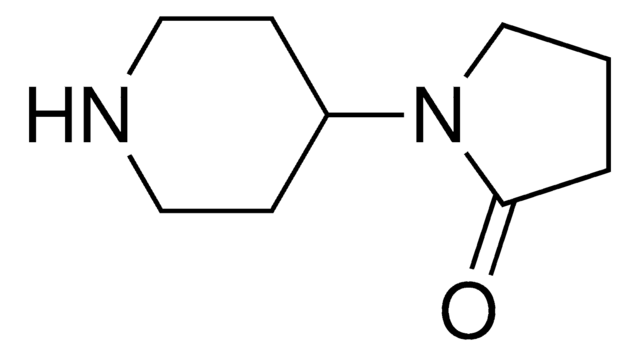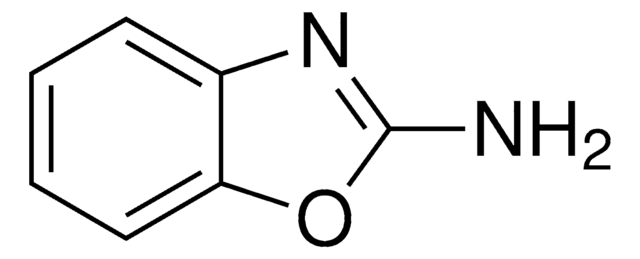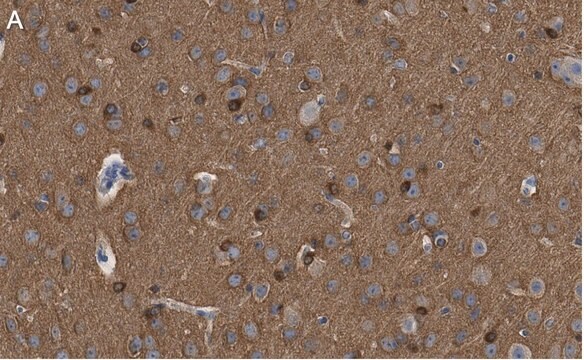MABN2406
ANTI-TAU (MAPT) Antibody
mouse monoclonal, TNT-2
Sinónimos:
EC:4.6.1.2, Guanylate cyclase 2D, retinal, Guanylate cyclase E (GC-E), Microtubule-associated protein tau, Neurofibrillary tangle protein, Paired helical filament-tau, PHF-tau, RETGC-1, ROS-GC, Retinal guanylyl cyclase 1, Rod outer segment membrane guanylate cyclase
About This Item
Productos recomendados
Nombre del producto
Anti-Tau Antibody, clone TNT-2, clone TNT-2, from mouse
origen biológico
mouse
Nivel de calidad
forma del anticuerpo
purified immunoglobulin
tipo de anticuerpo
primary antibodies
clon
TNT-2, monoclonal
mol peso
calculated mol wt 120.37 kDa
observed mol wt ~N/A kDa
purificado por
using protein G
reactividad de especies
rat, human, mouse
envase
antibody small pack of 100
técnicas
ELISA: suitable
immunofluorescence: suitable
immunohistochemistry: suitable
western blot: suitable
isotipo
IgG1κ
secuencia del epítopo
C-terminal
Nº de acceso NCBI
Nº de acceso UniProt
Condiciones de envío
ambient
temp. de almacenamiento
2-8°C
modificación del objetivo postraduccional
unmodified
Información sobre el gen
human ... MAPT(4137)
mouse ... Mapt(17762)
rat ... Mapt(29477)
Descripción general
Especificidad
Inmunógeno
Aplicación
Evaluated by Immunohistochemistry in mouse retina tissue section
Immunohistochemistry (Paraffin) Analysis (IHC): A 1:50 dilution from a representative lot detected Guanylate cyclase 1 in mouse retina tissue sections.
Tested Applications
Immunofluorescence Analysis: A representative lot detected Guanylate cyclase 1 in Immunofluorescence application (Ying, G., et al. (2018). J Biol Chem. 293(45):17546-17558).
Immunohistochemistry Analysis: A representative lot detected Guanylate cyclase 1 in Immunohistochemistry application (Haire, S.E., et al. (2006). Invest Ophthalmol Vis Sci. 47(9):3745-53).
Western Blotting Analysis: A representative lot detected Guanylate cyclase 1 in Western Blotting application (Haire, S.E., et al. (2006). Invest Ophthalmol Vis Sci. 47(9):3745-53).
Note: Actual optimal working dilutions must be determined by end user as specimens, and experimental conditions may vary with the end user.
Calidad
Western Blotting Analysis: 0.02 µg/mL of this antibody detected Tau in 10 µg of rat entorhinal cortex lysate.
Descripción de destino
Forma física
Reconstitución
Almacenamiento y estabilidad
Otras notas
Cláusula de descargo de responsabilidad
¿No encuentra el producto adecuado?
Pruebe nuestro Herramienta de selección de productos.
Código de clase de almacenamiento
12 - Non Combustible Liquids
Clase de riesgo para el agua (WGK)
WGK 1
Certificados de análisis (COA)
Busque Certificados de análisis (COA) introduciendo el número de lote del producto. Los números de lote se encuentran en la etiqueta del producto después de las palabras «Lot» o «Batch»
¿Ya tiene este producto?
Encuentre la documentación para los productos que ha comprado recientemente en la Biblioteca de documentos.
Active Filters
Nuestro equipo de científicos tiene experiencia en todas las áreas de investigación: Ciencias de la vida, Ciencia de los materiales, Síntesis química, Cromatografía, Analítica y muchas otras.
Póngase en contacto con el Servicio técnico








